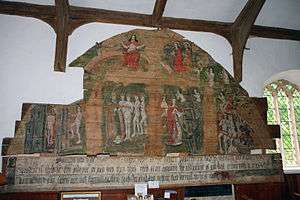Wenhaston
| Wenhaston | |
 Wenhaston, Church of St Peter |
|
 Wenhaston |
|
| OS grid reference | TM423756 |
|---|---|
| Shire county | Suffolk |
| Region | East |
| Country | England |
| Sovereign state | United Kingdom |
| Post town | Halesworth |
| Postcode district | IP19 |
| EU Parliament | East of England |
Coordinates: 52°19′30″N 1°33′14″E / 52.325°N 1.554°E
Wenhaston is a small village of 818 people (2001) situated to the south of the River Blyth in northeastern Suffolk, England.[1]
Roman coins, pottery and building materials unearthed in local fields indicate the existence of a settlement at Wenhaston from the 1st century AD, and indeed this was probably a market of some importance between 80 and 350 AD The first written record of its existence is to be found in the Domesday survey of 1086, when it was noted that the village of Wenadestuna possessed a mill, a church and woodland sufficient to feed 16 hogs. The place-name Wenhaston means 'Wynhaeth's town'.[2]

The village's greatest historical treasure is undoubtedly the Wenhaston Doom, a 16th-century (pre-Reformation) panel painting depicting the Last Day of Judgment. This rare work of art was discovered during restoration work in 1892, hidden under whitewash on the wooden tympanum taken down from above the chancel arch.
Today, the local community and economy of Wenhaston continues to benefit from its proximity to the Suffolk Heritage Coast and the flourishing resort town of Southwold. Wenhaston won the Suffolk Coastal Village of the Year 2004 competition and came second in the Suffolk County competition.
Wenhaston had a railway station on the Southwold Railway but this closed, with the rest of the line, on 11 April 1929.
The Anglian Bus services manage public transport in the area.
There is a thriving pig farm industry in the fields between Wenhaston and Blythburgh, which is also a village in the area around 2 miles from Wenhaston and around a 10- to 15-minute bicycle ride from Wenhaston.
Wenhaston is closely adjoined by the village of Blackheath, which has for years been considered a part of Wenhaston, bringing the population up to 1000 or more.
With Mells it forms the civil parish of Wenhaston with Mells Hamlet.
References
- ↑ The Parliamentary gazetteer of England and Wales. A Fullerton and Company, 1851, p. 473.
- ↑ Eilert Ekwall, The Concise Oxford Dictionary of English Place-names, p.506.
External links
![]() Media related to Wenhaston at Wikimedia Commons
Media related to Wenhaston at Wikimedia Commons
- Comprehensive, illustrated village website
- Wenhaston St. Peter church website
- Some photographs taken February 2004
- Wenhaston Doom
- GENUKI(tm) page
- Roman road through Wenhaston - Thayer